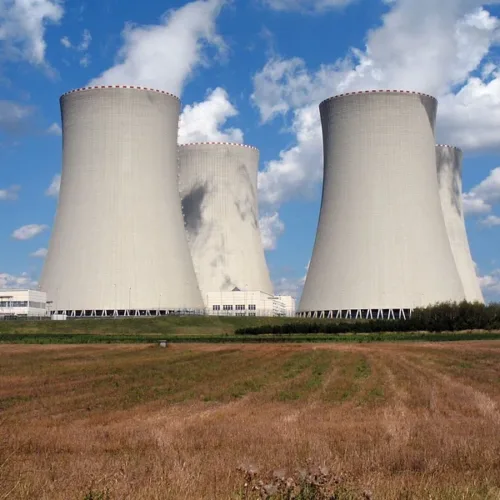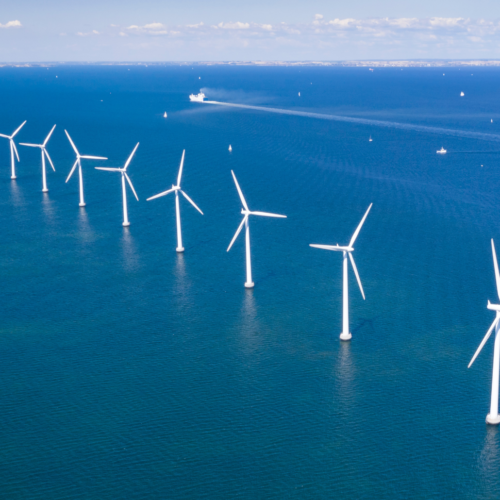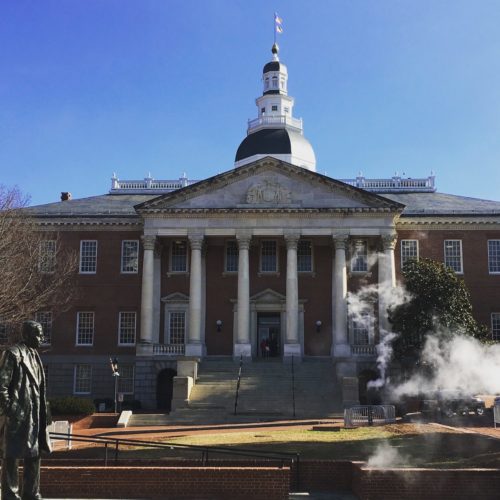Offshore wind ushers in a new energy economy
This article appears in the 2018-2019 edition of CSG East’s magazine, Perspectives.
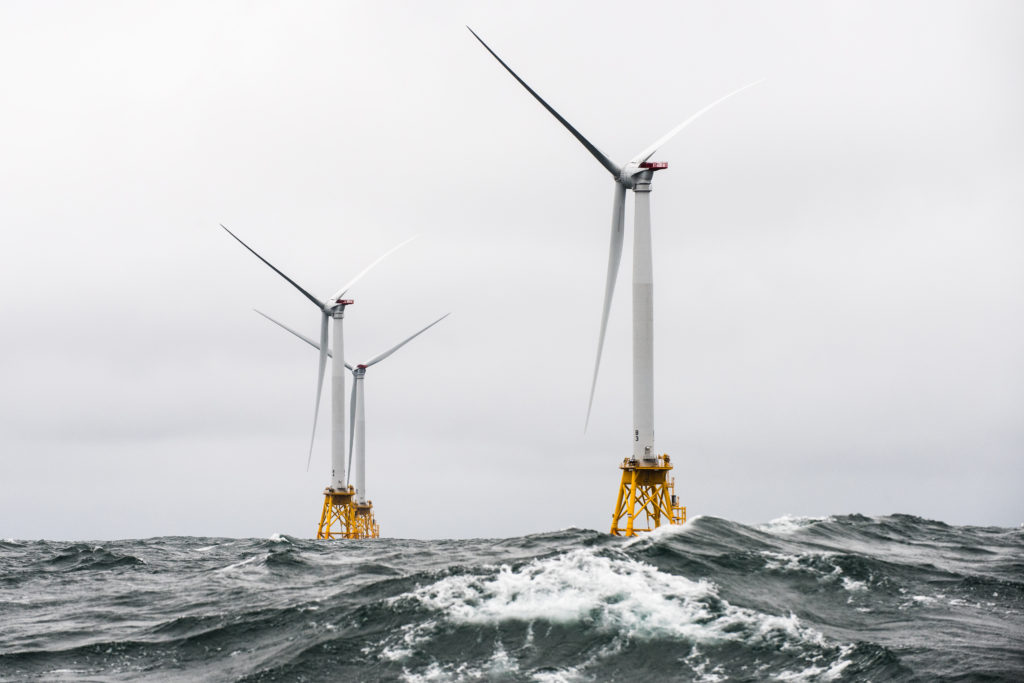
October 1, 2016 – Heavy seas engulf the Block Island Wind Farm, the first US offshore wind farm. The five Halide 6MW turbines were recently installed by Deepwater Wind, and are currently under commissioning. (Photo by Dennis Schroeder / NREL)
When Massachusetts energy officials announced the winning bid for the nation’s first major offshore wind farm in July, it was so low that even seasoned renewable energy experts expressed disbelief.
The price for power from the 800 megawatt Vineyard Wind project, slated for federal waters south of Martha’s Vineyard, was 18 percent cheaper than any available alternatives on the wholesale market. Officials said it will save consumers $1.4 billion over 20 years — a surprising development for a nascent technology that for years has been hampered by formidable cost and regulatory barriers in the United States.
“It was shocking,” said Massachusetts state Senator Marc Pacheco, who serves as Senate president pro tempore and is founding chair of the Senate Committee on Global Warming and Climate Change. “Even for those of us who have visited offshore wind farms in other countries over the years and understand the tremendous potential here, we were really amazed at the savings.”
Cost was a factor that doomed previous offshore wind proposals in the United States. The rates for the Cape Wind project, proposed in 2001 for the waters of Nantucket Sound, would have been two-thirds higher than Vineyard Wind’s. But better financing, new technologies, and experience gleaned in Europe are driving costs dramatically lower. Public policy has played a role, too. A Vineyard Wind official said that getting a long-term power purchase agreement and federal tax credits helped bring down the price for the project, which will be the first of several developments required by state law.
Massachusetts is among a group of East Coast states that have set ambitious targets for offshore wind, as part of a broader commitment to transition to a low-carbon energy system and collaborate on regional climate action.
Recently, an international panel of scientists warned that those efforts will need to accelerate to avoid devastating impacts from sea level rise, species loss, and extreme weather. The Council of State Governments/Eastern Regional Conference (CSG/ERC) has been convening policymakers from the region to share ideas about meeting this challenge in ways that are affordable and protect the most threatened communities.
Shared targets
In May, officials from 10 northeastern states traveled to Princeton University to attend a summit organized by the CSG/ERC Energy and Environment Committee, where they considered strategies to help fulfill their states’ commitments to decarbonize the way we produce and use energy.
Nearly every CSG/ERC jurisdiction has vowed to cut carbon emissions 80 percent by 2050, with the aim of limiting warming to 1.5 degrees Celsius (2.7 degrees Fahrenheit) above preindustrial levels — a boundary the international community has agreed is needed to prevent catastrophic effects.
During a keynote address, Robert Socolow, Princeton professor emeritus of mechanical and aerospace engineering, warned that the task confronting policymakers is enormous. The world has already experienced roughly 1 degree Celsius (1.8 degrees Fahrenheit) of warming since preindustrial times, and scientists forecast that unless there is a dramatic shift away from the burning of fossil fuels, temperatures will continue to rise.
Nevertheless, falling prices for solar and wind offer hope that the transition to low-emitting fuels can be affordable, he said. The average price of onshore wind in the United States has dropped by more than 70 percent since 2009, according to the U.S. Department of Energy, and prices for utility-scale solar energy have slid by roughly the same amount since 2010.
“Plummeting costs are the most exciting development of the last decade,” said Socolow during the summit, which was co-sponsored by the Andlinger Center for Energy and the Environment at Princeton.
A report released in October by the United Nations’ Intergovernmental Panel on Climate Change warned that nations must act quickly to transform the global energy infrastructure. Keeping warming to 1.5 degrees Celsius will require “rapid, far-reaching and unprecedented changes in all aspects of society,” including energy, transportation, and agriculture, within the next 12 years. Global greenhouse gas emissions must fall 45 percent below 2010 levels by 2030 and reach net zero by 2050 in order to avoid dire climate impacts, the report said.
“The good news is that some of the kinds of actions that would be needed to limit global warming to 1.5°C are already underway around the world, but they would need to accelerate,” said Valerie Masson-Delmotte, co-chair of the panel’s Working Group I, in a statement accompanying the report’s release.
Creating a new industry
Offshore wind is among the technologies that policymakers in Massachusetts are hoping will be part of the solution. In 2016, Governor Charlie Baker signed legislation requiring utilities to procure 1.6 gigawatts of offshore wind by 2027; in July, lawmakers doubled that target to 3.2 gigawatts by 2035, enough to supply more than 20 percent of the state’s energy needs. Among other things, the legislation was intended to ensure the power is affordable. It contains a provision requiring that each new offshore wind project come in at a lower price than the previous one.
Prices are already falling faster than anticipated. The Vineyard Wind project is more than 60 percent cheaper than the next-lowest price for a U.S. offshore wind farm, which came in Maryland’s 2017 auction for a 368 megawatt project.
Declining costs bode well for New Jersey and New York, which collectively seek to develop nearly 6 gigawatts of offshore wind in a little more than a decade — roughly the output of six nuclear power plants. There is hope that such a massive supply of power could serve as a replacement for aging nuclear reactors set to retire in the coming years and stimulate the regional economy. A string of utility-scale projects could bring investment in a vast local manufacturing supply chain, creating jobs and further driving down costs.
As with any new technology, there will be growing pains as new projects advance. Massachusetts has held more than 100 stakeholder meetings to address questions about impacts on the fishing industry, avian life, and transmission siting and ownership, among other concerns. The state of New York recently received an $18.5 million grant from the U.S. Department of Energy to lead a research and development consortium to work through some of these issues nationwide. Some 25 gigawatts are in various stages of development in federal waters along the U.S. coasts and in the Great Lakes.
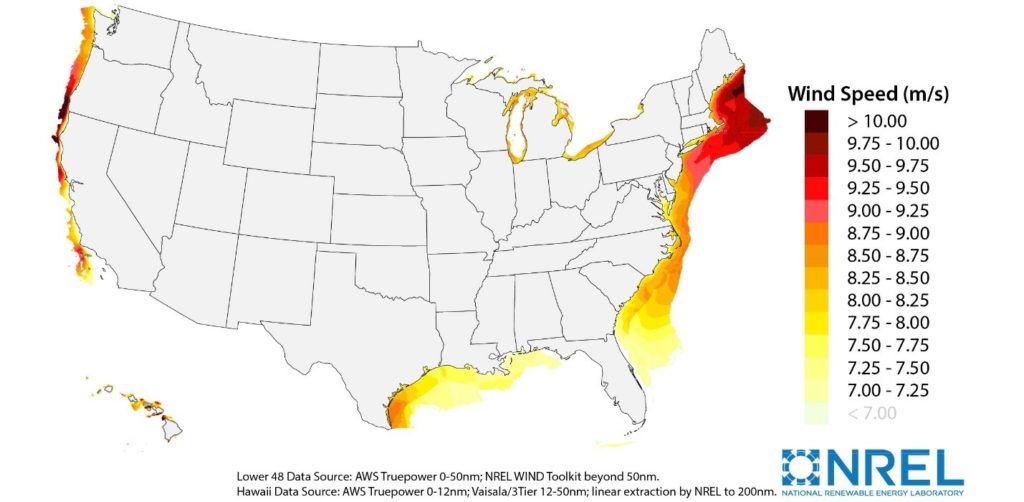
Credit: National Renewable Energy Laboratory
Ramping up renewables mandates
State support for offshore wind fits into a trend among lawmakers, primarily in the Northeast and in the West, to push for more generation from zero-emission energy sources.
Under a 2015 Vermont law, 75 percent of the state’s power must come from renewables by 2032; earlier this year, Massachusetts and New Jersey raised their renewables target to 50 percent by 2030, a goal shared by New York.
In the West, California and Hawaii are aiming even higher: Both states have established mandates of 100 percent by 2045, though their approaches differ. Hawaii must get all of its power from renewable sources by its deadline. California’s law, enacted earlier this year, calls for 100 percent carbon-free power — a definition that could include nuclear generation and carbon capture and sequestration. Given that California has the world’s fifth-largest economy, its mandate could prove the feasibility of transitioning to zero-carbon fuels on a scale never seen before.
As these policies advance, there will be challenges around incorporating massive quantities of intermittent power into a system that was designed to accommodate large, centralized coal, nuclear, and oil-and-gas plants that can run around the clock. States are addressing issues around siting and permitting; wholesale markets; utility business models; and fair compensation for generators of solar, wind, energy efficiency, and other distributed resources.
California and a few northeastern states have also set targets for energy storage, understanding that tremendous investment will be needed in batteries and other utility-scale storage options to supplement solar and wind when the sun doesn’t shine and the wind doesn’t blow.
Powering vehicles
While state and federal mandates have been critical in driving deployment of renewables, plummeting costs are widely expected to accelerate their development, perhaps exponentially. Wind and solar are now cheaper than building new coal plants and cost-competitive with new combined-cycle natural gas plants across the United States, according to Lazard, an international financial advisory firm.
A similar global trend is fueling record deployment, particularly of solar energy. In 2017, more solar capacity was added worldwide than the new additions of coal, gas, and nuclear power combined, said the Paris-based International Energy Agency.
Continued integration of renewables is expected to help tackle the largest source of carbon emissions in the United States — transportation — by supporting electric vehicle use.
Although electric vehicles currently represent only 1 percent of the U.S. vehicle fleet, major automakers have invested billions of dollars in battery technology and artificial intelligence, and they are preparing to roll out large numbers of commercial models in the next few years.
In a report released in June, Bloomberg New Energy Finance anticipated that time-of-use tariffs and dynamic pricing will allow vehicle owners to choose to charge during high-supply, low-cost periods, which will help to shift demand to periods when cheap renewables are running.
The report forecast that renewables will make up 50 percent of global energy demand by 2050, driven by dramatic reductions in the cost of solar, wind, and batteries. In the United States, wind and solar produced less than 8 percent of overall power generation in 2017.
During the 2018 CSG/ERC Annual Meeting in Rye Brook, New York, Stanford University instructor Tony Seba predicted an even faster transition away from fossil fuels — along with the massive emissions reductions that UN scientists warn are essential.
In a presentation during the meeting’s opening plenary session, Seba asserted that by 2030 wind and solar will be so cheap that they will make up all new generation. By then, most vehicles will be autonomous and powered by batteries, leading to a 90 percent drop in emissions from transportation, he said.
“This will happen for purely economic reasons,” said Seba, who is co-founder of the think tank RethinkX and the author of the book Clean Disruption of Energy and Transportation.
“Solar and wind and storage are going to eat everything. And that tipping point is two to three years away,” he said.
Seba’s message was encouraging to policymakers who are determined to find an affordable path to a low-carbon economy, although few were convinced that the marketplace alone would transition us away from fossil fuels with the scale and timing that states and the international community are seeking, absent a government push. Nevertheless, there was optimism that costs in the region were moving in the right direction.
